What are niche edits and how can they transform your link building strategy?
link-building
While many SEO professionals are still writing guest posts from scratch and waiting months to see results, smarter marketers are using a faster, more cost-effective way to build quality backlinks. It’s called niche edits, a link building strategy that’s quietly changing how we approach contextual links.
Instead of writing new content, marketers use niche edits by placing their links inside articles that are already published on trusted, high-authority sites. It’s a faster, more efficient way to earn backlinks, and in many cases, it delivers quicker SEO results than writing guest posts or sending cold outreach emails.
If you’re tired of the slow guest posting process or just want to speed up your SEO efforts, you’re in the right place. This guide will show you exactly how niche edits work, how to use them safely, and how to get the most from them.
By the end, you’ll see why niche edits are now one of the go-to link building tactics for SEO pros and how you can use them to boost your search engine rankings without all the extra content work.
What are niche edits?
Niche edits, also known as link insertions or contextual backlinks, are a smart and more organic way to approach link building. Instead of writing brand-new content like a guest post, you place your backlink into an already published article on a relevant website. Since the content is already indexed and trusted by search engines, your backlink gets the benefit of that authority from day one.
How niche edits work?
If you’re diving into niche edits, it’s important to really understand how the process works. Instead of just chasing backlinks, the focus is on finding solid content that’s already doing well and figuring out where your link can naturally fit in. A good niche edit link building strategy isn’t just about dropping links; it’s about reaching out to the right site owners, offering real value, and making sure the link helps both you and them.
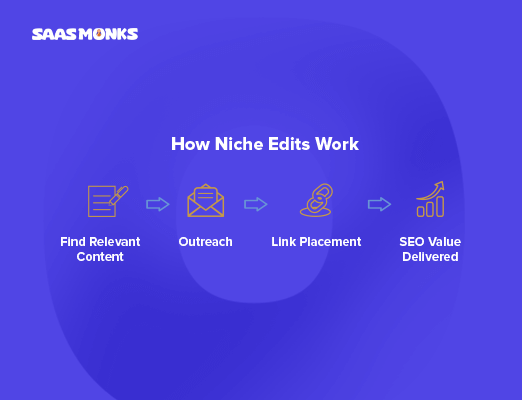
The identification process
The first step is to use tools like Ahrefs, Moz, or SEMrush and start looking for existing blog posts or already published articles that fit your niche. You want content that’s ranking well for relevant keywords,
comes from sites with decent domain authority, and gets steady organic traffic. That’s the kind of page where your link can actually make a difference.
Effective prospecting focuses on specific types of content that tend to work well for niche edit opportunities:
- “Best of” lists and resource roundups
- Industry guides and how-to articles
- High-traffic blog posts with established readership
- Resource pages that curate valuable industry links
Outreach and relationship building
Once you’ve found some potential targets, the next step is tracking down the right person to contact, usually the site owner or editor. Tools like Hunter.io can help you find email addresses, but sometimes you’ll need to get creative and use contact forms or even reach out via social media.
The secret to good outreach? Show genuine value. Instead of just asking for a link, explain how your content adds something useful to their existing article, whether it’s updated info, deeper insights, or a helpful resource. You can also try press mention niche edits by spotting unlinked brand mentions in their content and politely asking them to turn it into a backlink.
Integration and implementation
Once a site owner gives the green light by agreeing to your niche edit request, your job is to make sure the link fits smoothly into their existing web page content, like it was meant to be there from the start. That could mean adding a new sentence or short paragraph that references your resource, or simply linking an existing phrase that already aligns with your topic.
The best niche edit link placements feel organic and contextual. Readers should feel like the link fits right where it is and actually adds something useful to their experience.
Types of niche edits and their risk levels
Not all niche edits are the same. Selling niche edits as a service, especially when money is involved, can be risky if you’re not careful. That’s why it’s important to understand the different approaches and what risks come with each, so you can build a smart, long-term strategy that stays on the safe side of search engine guidelines.
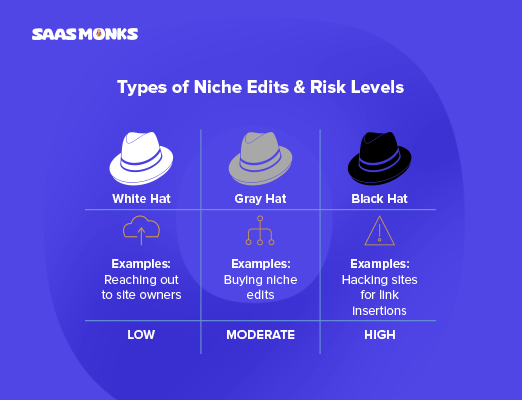
White hat niche edits
White hat niche edits are the most reliable and risk-free way to approach link building. They’re all about reaching out to websites that are a good fit and offering something genuinely useful. When your content is high quality and relevant, you earn the link because it adds real value, not because you paid for it or offered an incentive.
Characteristics of white hat niche edits include:
- Manual outreach to high quality websites in your industry
- Genuine value exchange that benefits the site owner’s audience
- Adherence to Google’s guidelines for natural link building
- Focus on relevance and context rather than just metrics
- Long-term relationship building with quality website owners
- Result in white hat links that are valued by search engines for their legitimacy and sustainability
This approach takes more time and effort but provides sustainable results that align with search engine quality standards. The key is to bring something truly useful to the table. That could be updated information, a stronger resource, or added context that improves the existing content.
Gray hat niche edit approaches
Gray hat niche edit tactics occupy the middle ground between completely ethical and clearly manipulative practices. These usually involve paying for link placements, which technically go against Google’s guidelines. Still, it’s something that happens a lot across the industry.
Common gray hat approaches include:
- Paying site owners for link placement opportunities
- Using a niche edits service to facilitate paid placements
- Incentivizing link placements through product samples or other compensation
- Building links through reciprocal arrangement networks
While these methods can be effective and are less risky than black hat tactics, they do carry the potential for penalties if detected. Plenty of successful SEO campaigns use a few gray hat niche edit tactics, but it’s important to choose the right vendors and keep a close eye on quality to avoid unnecessary risks.
Black hat niche edits and what to avoid
Black hat niche edits are risky and can do more harm than good. If you’re serious about long-term SEO, it’s best to avoid them altogether and focus on strategies that actually build trust and lasting results.
Dangerous black hat approaches include:
- Using private blog networks (PBNs) for niche edit placements
- Hacked links placed without site owner knowledge or consent
- Automated link insertion tools that spam multiple sites
- Placement on low quality links farms or irrelevant pages
- Excessive use of exact-match anchor text across multiple placements
These tactics might provide short-term ranking boosts, but they carry significant risks of algorithmic penalties, manual actions, or complete deindexing from search results.
Benefits of niche edits for modern SEO
Truth is, the real power of niche edits isn’t just about saving a few bucks. It’s about how they fit into a smarter link building strategy. When done right, they can seriously speed things up, giving your SEO campaigns a real push and helping you rise in search engine rankings without the usual wait.
And the best part? A authoritative niche edit from a trusted, high-traffic site sends real signals to Google. It’s not just any backlink; it’s one that carries weight because it’s coming from a place that already has authority.
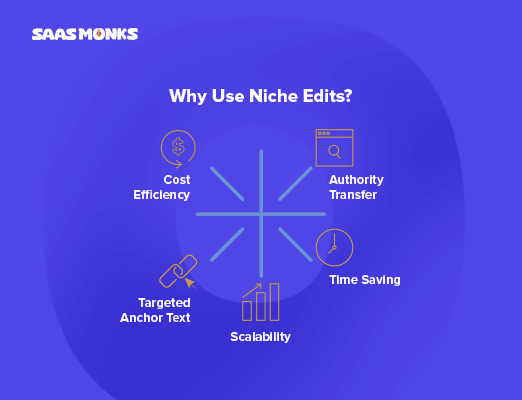
Cost and time efficiency
One of the biggest advantages of niche edits is how much time they save compared to writing full guest posts from scratch. Putting together a quality guest post can easily eat up 8 to 12 hours between researching, writing, editing, and going back and forth with revisions. In contrast, a standard niche edit usually takes just 2 to 3 hours mainly for finding the right sites and doing some link building outreach. That time savings adds up quickly, especially if you’re doing this at scale.
That kind of efficiency can lead to real cost savings. While most niche edit placements typically run between $150 and $800, guest posts often cost significantly more sometimes $250 to $1,200 or more, when you add in the time, effort, and cost of writing new content and meeting editorial guidelines.
Immediate authority transfer
Unlike brand-new guest posts that have to earn trust and build authority from scratch, niche edits tap into the existing authority and link juice of pages that are already doing well. You’re not starting from zero, instead, you’re adding your link to content that’s already indexed, ranking, and pulling in traffic. That means the high quality link you gain starts working right away, giving you immediate value simply because it’s coming from a page that search engines already trust.
That’s valuable because older content tends to carry more weight. Over time, search engines have had a chance to assess its quality, see how users engage with it, and decide if it deserves to rank. All that built-up trust makes these pages great spots for passing on authority through a well-placed link.
Enhanced control and targeting
One of the big advantages of niche edits is the level of control they give you, particularly when it comes to anchor text and where your link appears within a piece. Unlike some other link building strategies, you’re often able to choose exactly where your link goes and how it’s framed in the surrounding content.
Having this kind of control makes it easier to target the right keywords and align your backlinks with your overall SEO plan. Instead of relying on a guest post editor to use your ideal anchor text, you can usually work out the exact placement and context that best supports your strategy.
Scalability advantages
Because niche edits don’t require content creation, they can be scaled more easily than guest posting campaigns. Once you’ve got solid outreach templates and figured out what gets results, you can often secure several high-quality niche edit backlinks in the time it would take to produce and place a single guest post.
That kind of scalability is a big reason why niche edits are so appealing for bigger SEO campaigns or businesses that need to grow their backlink profiles fast and at scale..
Safe strategies for acquiring niche edits
Niche edits offer some great advantages, but getting real results depends on how thoughtfully and strategically you use them. When done right, they’re a smart way to build high quality links without taking unnecessary risks. The following strategies ensure you build valuable backlinks while minimizing the risk of penalties or negative SEO consequences.
Broken link building integration
One of the most practical and ethical ways to use niche edits is by pairing them with broken link building. The idea is simple: you find broken links on relevant websites and suggest your content as a replacement. While you’re at it, you can also recommend adding a link to another piece of related content you’ve created, making the update even more valuable for the site owner.
The process works like this:
- Use tools like Ahrefs to find broken outbound links on authoritative sites in your niche
- Verify that the broken link previously pointed to content similar to yours
- Reach out to the site owner highlighting the broken link issue
- Offer your content as a replacement for the broken resource
- Suggest additional contextual links that would enhance the existing content
This method offers real value to site owners by helping them improve user experience and fix issues on their pages. Because it benefits both sides, broken link building often sees better success rates and leads to more lasting relationships.
Unlinked brand mentions strategy
Another highly effective approach focuses on converting existing unlinked brand mentions into valuable backlinks. Many websites mention brands, products or people without linking to them, offering easy opportunities for ethical link building.
To implement this strategy:
- Set up Google Alerts for your brand name, key personnel, or products
- Use tools like Mention or Brand24 to monitor web mentions across platforms
- Identify high-quality sites that mention you without linking
- Reach out with polite requests to convert mentions into links
- Offer additional value or context that enhances their existing content
This approach works well because you’re not asking them to create anything new, just asking to improve existing content by adding a helpful link that makes the piece more useful for readers.
Resource page link building
Resource pages are some of the best places to look for niche edit opportunities. These curated pages are built to share useful links and resources within an industry, which makes them a perfect place for adding high-quality, relevant links.
Effective resource page targeting involves:
- Identifying industry resource directories and curated link collections
- Analyzing existing links to understand quality standards and relevance criteria
- Crafting pitches that emphasize the value your content adds to their collection
- Following up professionally while respecting editorial processes
- Building relationships with resource page maintainers for long-term opportunities
Niche edits on resource pages can offer great long-term value because these pages are usually kept up-to-date, which means your links are more likely to stay live and continue delivering SEO benefits over time.
Quality criteria for evaluating niche edit opportunities
Success with niche edits really comes down to how well you can spot high-quality opportunities and avoid the ones that could hurt your site. Placing your links in strong, relevant content makes a big difference, it not only improves SEO impact but also makes webmasters more likely to approve your placements. One way to stay on track is by using the RAD method:- short for Relevance, Authority, and Due Diligence. It’s a simple framework that keep your outreach focused and make sure your links actually add value.
Relevance assessment
Relevance is the backbone of any worthwhile niche edit. With search engines placing more weight on contextual alignment, it should always be your first checkpoint when evaluating a potential niche edit link building opportunity.
Here’s what to look for:
Topical alignment:
The existing content should clearly relate to your industry, product, or service. For example, a niche edit on a fitness blog is a great fit for a supplement brand but not for an accounting software company.
Audience overlap:
Think about who’s reading the page. Would they actually find your content useful? The most effective niche edit links speak to an audience that already overlaps with your target market.
Content context:
Make sure your link fits naturally within the flow of the existing content. If the link feels forced or too promotional, it can hurt both your credibility and performance of the page in search engines.
Geographic relevance:
If you’re targeting a local audience, try to get links from pages that align with your location. That geographic connection adds extra weight in local search engine rankings and helps your link feel more relevant to readers.
Authority evaluation
Authority isn’t just about domain metrics, it’s about trust and credibility. While tools like Ahrefs, Moz, and Majestic can give you a quick read on a site’s Domain Rating or Trust Flow, those numbers only tell part of the story.
Here’s what a more complete authority check should include:
Domain metrics:
Check site authority using tools like Ahrefs (Domain Rating), Moz (Domain Authority), or Majestic (Trust Flow/Citation Flow). Just remember these scores are helpful, but they shouldn’t be your only deciding factor.
Content performance:
Don’t just look at the site’s overall authority, check how the specific page is doing. Is it ranking for relevant keywords? Does it bring in steady organic traffic? Even a high-authority domain won’t help much if the content itself isn’t performing well.
Backlink profile quality:
Take a close look at the site’s existing backlinks. Do they come from reputable sources? Avoid sites with spammy patterns or low editorial standards. It’s a sign they’re more interested in selling links than maintaining quality.
Content freshness:
Sites that are regularly updated tend to pass more trust. If the content looks abandoned or hasn’t been touched in years, it’s probably not a great spot for a niche edit link.
Due diligence and risk assessment
Due diligence is a key to keeping your SEO campaign safe and sustainable. It helps you avoid risky links and focus on building long-term value.
Here are a few essential checks:
PBN detection:
Look for signs that a site might be part of a private blog network, by checking things like thin content, low-quality links, or strange ownership details in the WHOIS info. If it looks suspicious, it’s probably best to skip it.
Editorial standards:
Make sure the site publishes genuinely useful content, not just sponsored posts or commercial material.
Outbound link analysis:
Check where they’re linking. Do the links look editorially chosen, or does it feel like they’ll link to anything for a fee?
Historical performance:
Use tools like the Wayback Machine to check how the site has changed over time. Watch for sudden changes in the site’s content, ownership, or linking patterns. These can be signs that the site may no longer be as trustworthy as it used to be.
Google compliance:
Always follow Google’s guidelines to avoid penalties and protect your long-term search engine rankings.
Content suitability for niche edit link insertion
Not all content is created equal, especially when it comes to inserting niche edit links. If you’re investing in a niche edits service, you need to be mindful of where and how you’re placing those links. Let’s walk through the key things you need to know.
Informational vs. Commercial content: What works best?
When it comes to niche edit backlinks, the type of content matters more than you think.
- Informational content (like guides, tutorials, or how-tos) is the sweet spot for inserting contextual links naturally.
- If a piece of content is already sounding too promotional, inserting a link into the middle of it can feel pushy and even spammy, to both readers and search engines. It may also raise red flags with Google’s guidelines.
- Why informational works? It helps white hat niche edits fit naturally into the content, making them more useful for readers and more trustworthy in the eyes of search engines.
Tip: Think blog posts answering user questions, not landing pages selling a product.
Where to avoid link insertions
There are some places where niche edit links just don’t belong:
- YMYL (Your Money Your Life) content like health, finance, or legal pages can be risky for sites that lacks E-E-A-T (Experience, Expertise, Authoritativeness, and Trustworthiness).
- Medical advice articles, unless you’re citing peer-reviewed research or you’re a verified expert. Google tends to be very strict about them.
- Pages that are already packed with outbound links or blog posts cluttered with too many external references. These dilute link juice and hurt domain authority.
If a page relates to someone’s health, finances, or overall well-being, it’s important to be careful with, how you approach link building.
Content quality should match link intent
For niche edits SEO to really work, the content where you’re inserting links needs to be high quality and contextually relevant.
Here’s what to aim for:
- Topical relevance: Your link should help the reader better understand the topic, not take their attention away from it.
- High-quality content: Well-written, engaging, and updated posts are the best home for quality niche edits.
- Organic fit: If the anchor text feels forced, it won’t help your SEO or your reader.
- Avoiding outdated or irrelevant blog posts: These don’t carry the same weight and might even harm your search engine rankings.
Use broken link building or check resource page link building opportunities to discover existing content that can be revived with your link.
Niche edits vs guest posting: a comprehensive comparison
Knowing when to use niche edits vs. guest posts can make a big difference in your link building strategy. Both aim to improve your rankings by building quality backlinks, but they work in different ways and each has its own advantages. The right choice really depends on what you’re aiming for, how fast you need results, and the resources you’ve got to work with.
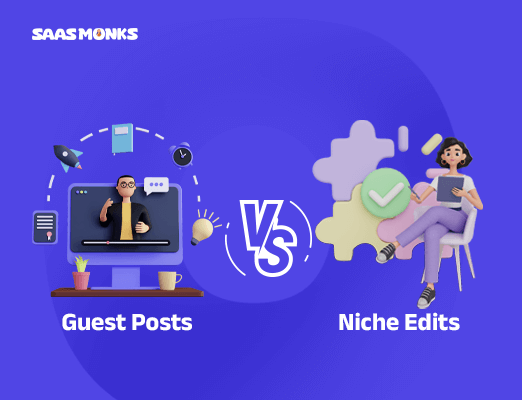
Factor | Niche Edits | Guest Posting |
|---|---|---|
Content requirement | No new content creation needed | 800-2,000 words of original content required |
Timeline | 2-4 weeks typical | 4-12 weeks common |
Average cost | $150-$800 per link | $250-$1,200+ per placement |
Link control | High anchor text control | Limited by editorial guidelines |
Editorial scrutiny | Minimal review process | Extensive editorial review |
Authority transfer | Immediate from existing page | Delayed until new page gains authority |
Relationship building | Transactional focus | Long-term relationship potential |
Content ownership | No content assets created | Builds content portfolio |
Brand exposure | Limited brand visibility | Significant brand exposure opportunity |
Conversion rates | 3-5% typical response rate | 10-15% typical acceptance rate |
When to choose niche edits
Niche edits work best when you need:
- Fast SEO results with immediate authority transfer
- Cost-effective link building at scale
- Precise control over anchor text and placement
- Links from established, ranking content
- Minimal time investment per link acquired
When guest posting remains superior
Guest posting offers advantages for:
- Building long-term relationships with industry publications
- Establishing thought leadership and brand authority
- Creating owned content assets that provide ongoing value
- Targeting publications with strict editorial standards
- Building comprehensive content marketing strategies
The most effective SEO campaigns tend to use a mix of both.Niche edits are perfect when you want faster results and to tap into existing authority, while guest posts are better for building long-term relationships and getting your brand in front of the right audience. It’s all about using each tactic where it makes the most impact.
Content example comparison
Let’s see how niche edits actually work in real content.
Take a look at this before/after:
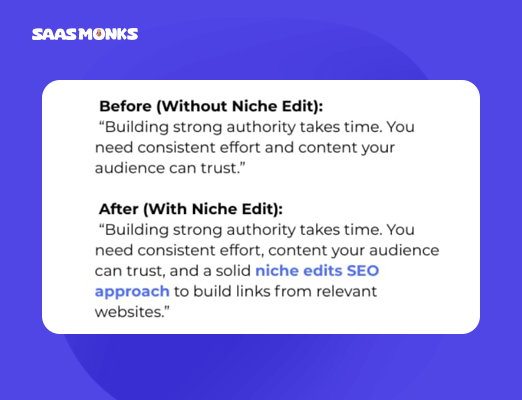
See how it blends into existing content without sounding promotional? That’s what makes niche edit links so effective, they maintain flow, stay contextual, and follow Google’s guidelines when done right.
Whether you’re targeting high-authority domains, resource pages, or existing blog posts, the goal is simple: insert a white-hat niche edit that adds value without breaking the reader’s trust.
Step-by-step niche edit implementation process
Running a successful niche edit campaign takes a step-by-step approach. Breaking it down into clear phases helps you stay consistent, keep quality high, and get reliable results over time.
Phase 1: Target identification and prospecting
Step 1: Define your target criteria
Begin by establishing clear parameters for potential targets:
- Minimum domain authority (typically 30+ for most campaigns)
- Relevance requirements (industry, audience, content type)
- Traffic thresholds (minimum monthly organic traffic)
- Content age preferences (usually 6+ months old for established authority)
Step 2: Prospect research
Use SEO tools to identify potential targets:
- Search Ahrefs for competitors’ backlinks to find linking opportunities
- Identify high-ranking content in your niche using keyword research
- Look for “best of” lists, resource roundups, and industry guides
- Build a prospect list of 50-100 potential targets for campaign scalability
Step 3: Qualification and prioritization
Evaluate each prospect using the RAD methodology:
- Verify relevance through content analysis and audience assessment
- Confirm authority through multiple metric sources
- Complete due diligence to identify potential risks or red flags
Phase 2: Contact discovery and outreach
Step 4: Contact information gathering
Locate decision-makers through multiple channels:
- Check website contact pages and about sections
- Use email finder tools like Hunter.io for direct contact discovery
- Search social media profiles (LinkedIn, Twitter) for editorial contacts
- Try contact forms when direct emails aren’t available
Step 5: Outreach execution
Craft personalized outreach that emphasizes value:
- Reference specific content details to demonstrate genuine interest
- Explain how your link enhances their existing content
- Provide ready-to-use copy suggestions to simplify implementation
- Avoid overly promotional language that triggers spam filters
Step 6: Follow-up strategy
Implement systematic follow-up to maximize response rates:
- Send 2-3 follow-up emails spaced 5-7 days apart
- Vary your approach in each follow-up while maintaining professionalism
- Track open rates and responses to optimize future outreach
- Know when to stop following up to avoid damaging relationships
Phase 3: Implementation and tracking
Step 7: Link placement coordination
Work with site owners to ensure optimal placement:
- Provide specific placement suggestions within their content
- Offer contextual copy that integrates naturally
- Confirm anchor text preferences while respecting their editorial standards
- Request placement in contextually relevant sections rather than generic locations
Step 8: Verification and monitoring
Ensure successful implementation and ongoing value:
- Verify link placement and confirm it follows your specifications
- Add new backlinks to your tracking spreadsheet or tools
- Monitor link status regularly to catch any removals quickly
- Track the SEO impact through ranking and traffic changes
Common mistakes that undermine niche edit campaigns
Avoiding common outreach mistakes can make a big difference in how well your niche edit campaigns perform and help protect your SEO investment.

Outreach and relationship mistakes
Being overly promotional:
Many outreach attempts fail because they focus on what the sender wants rather than what value they provide. Effective niche edit outreach focuses on how the link adds value for the site’s owner’s audience.
Generic templating:
Emails that sound copy-pasted or overly generic usually get ignored. For outreach to work, it needs to feel personal and show that you’ve taken the time to read and understand their existing content and why your link makes sense there.
Inadequate follow-up:
Most people stop after one or two emails, but research shows that over 80% of conversions happen after five or more follow-ups. Staying consistent with your outreach can make a big difference in results.
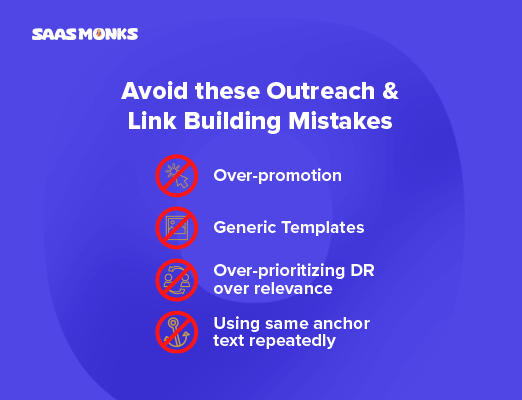
Target selection errors
Prioritizing metrics over relevance:
If you’re choosing sites just because they have high traffic or domain authority without checking their relevance, then you’ll likely end up with links that add little to no SEO value.
Ignoring editorial standards:
Adding links to sites that lack proper editorial oversight or openly sell links can hurt your SEO in the long run and increase the risk of penalties.
Insufficient due diligence:
If you don’t take the time to properly review a site for spam signals, PBN activity, or overall quality, you could end up with backlinks that do more harm than good.
Implementation and scaling issues
Moving too quickly:
If you build too many links too quickly, it can look suspicious to search engines. A better approach is to spread your niche edits out over time. That way, your link profile grows more naturally and you’re less likely to run into issues down the road
Neglecting anchor text diversity:
If you keep using the exact same anchor text in every link, it starts to look spammy. Insted, use different but relevant variations of anchor text that make sense in context and keep it natural.
Poor record keeping:
If you’re not tracking your outreach, replies, and placements, it’s hard to know what’s working and even harder to measure ROI or to optimize future campaigns. Keeping good records make it way easier to improve your strategy and see what’s actually working.
Measuring niche edit campaign success
Measuring success isn’t just about counting links. What really matters is the impact those links have on your SEO performance and overall business results.
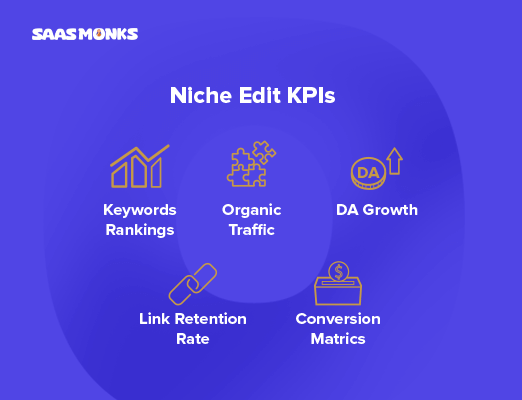
Key performance indicators
Ranking improvements:
Make sure you’re tracking what’s your target keywords position in search engine, take a look around 30, 60, and 90 days after your links go live. Tools like Google Search Console, Ahrefs, or SEMrush are great for spotting trends and seeing what’s working.
Organic traffic growth:
Track your overall organic traffic growth by paying close attention to the traffic coming from your target keywords. Some results might show up quickly, while others take time to build.
Domain authority progression:
While domain authority isn’t a direct Google ranking factor, it’s still a helpful indicator. If your DA is going up, it usually means you’re building strong backlinks and boosting your site’s overall authority.
Conversion and revenue impact:
At the end of the day, traffic is great, but results matter more. Keep track of how your SEO gains are translating into leads, signups, sales, or whatever actions matter most for your business.
ROI calculation methods
Calculate niche edit ROI using this framework:
Cost per link: Include all expenses (outreach tools, time investment, link placement fees)
Traffic value: Estimate the monetary value of additional organic traffic based on your typical conversion rates and customer values
Competitive advantage: Consider the opportunity cost of competitors acquiring the same high-value links
Most successful niche edit campaigns achieve positive ROI within 3-6 months, with some seeing immediate benefits from placement on high-traffic, relevant pages.
Long-term impact assessment
Link retention rates:
Check in regularly to see how many of your niche edit links are still live. If they’re high-quality and placed on trustworthy sites, most of them should still be there after a year. Aim for at least 85% retention as it’s a good sign your campaign was done right.
Authority ripple effect:
Check the ripple effect of your first niche edits. Those links often boost your site’s overall authority and improve rankings for keywords you didn’t specifically target.
Relationship development: Track how many initial niche edit contacts develop into ongoing partnerships or additional linking opportunities.
Legal and ethical best practices for niche edits
Google’s stance is clear:
If you’re paying for niche edit backlinks that pass link juice, you must disclose it with a nofollow or sponsored tag. Google’s policies are clear on this and ignoring them can land your site in hot water.
No room for grey hat tricks:
Inserting links into hacked websites or using private blog networks is a red flag. These gray hat niche edits might give you a quick boost, but they come with serious long-term risks, like getting penalized or losing your search rankings altogether.
Transparency is key:
It’s totally okay to collaborate with site owners and get your link added to a relevant piece of content. Just be upfront about it. If there’s payment involved, disclose it. If it’s a partnership, keep things clear. What matters is staying honest and not trying to fool the algorithm.
Stick to editorial-based niche edits:
White hat niche edits that are contextually placed in existing articles or relevant blog posts, and offer real value, align with Google’s expectations for quality niche edits.
Avoid over-optimized anchor text:
Using manipulative or keyword-stuffed anchor text in your niche edit link building strategy can appear spammy. Keep it natural and relevant to maintain credibility.
Follow ethical link building tactics:
The goal of niche edit services should be to offer contextual backlinks that benefit readers and blend naturally into existing blog posts, just like good broken link building or resource page link building practices.
Be cautious with paid placements:
If you’re paying for niche edits, make sure everything’s transparent. Focus on getting links from relevant, high-quality sites, not spammy pages loaded with outbound links. Quality over quantity always wins in the long run.
Editorial integrity matters:
Work only with website owners who control and care about their domains. Niche edits SEO should enhance the content, not just sneak in a backlink.
Stay aligned with Google’s guidelines:
Whether you’re adding niche edit links for your own site or offering them as a service, staying within Google’s rules helps keep your strategy safe, scalable, and sustainable.
The future of niche edits in evolving SEO
As search engines get smarter, the way we approach niche edits is also evolving. What used to work a few years ago, like mass link placements, paid edits with little context isn’t working anymore. The focus now is shifting toward quality, relevance, and genuine editorial value.
How algorithm changes are shaping the game
Recent Google updates make it clear: the algorithm is getting smarter at telling the difference between genuine and forced links. It now favors links that are naturally placed because they add value to the content, not ones that are there just because someone paid for them.
Editorial links are holding their ground
Links that genuinely belong in the content (and make sense for the reader) are becoming more important than ever. On the flip side, links that are clearly commercial or forced into unrelated content are starting to lose power.
E-A-T integration:
Google’s focus on Expertise, Authoritativeness, and Trustworthiness (E-A-T) means links placed on truly authoritative, trustworthy websites are more likely to hold long-term value. It’s not just about where the link is, it’s about how credible the content around it is.
Content quality focus:
When links are placed in genuinely useful, well-researched content that aligns with what readers are looking for, they’re far more likely to deliver lasting SEO value.
User experience priorities:
Niche edits that improve the reader experience and offer real value tend to stay effective in the long run, because if it feels natural for a human, it probably works for Google too.
How industry practices are changing
Increased transparency:
Instead of just paying for links, successful campaigns now focus on building actual relationships with publishers. That might mean offering useful updates to old content, suggesting better sources, or simply making a connection before requesting a placement.
Quality over quantity:
It’s no longer about chasing hundreds of backlinks. A few high-quality, well-placed niche edits can often do more for your rankings than a flood of mediocre (low-value or irrelevant) backlinks.
Integration with content strategy:
Smart marketers aren’t treating niche edits as a standalone tactic anymore. They’re baking them into their broader content plans, using edits to support their articles, resource hubs, and pillar pages.
Technology and automation impacts
AI-powered prospecting:
New tools can now help pinpoint exactly where your link fits best. Instead of sifting through thousands of irrelevant blogs, AI-powered software can highlight high-authority sites that match your niche.
Relationship management systems:
CRM-style systems designed specifically for link building are streamlining how we manage conversations with site owners. It’s no longer just about sending bulk emails; it’s about managing real, ongoing relationships.
Quality assessment automation:
Modern tools can also help you avoid risky sites by flagging red flags, like spammy link patterns or sites with low authority before you reach out.
Positioning SaaSMonks as your niche edit solution
Executing effective niche edits takes more than just finding a link and placing it somewhere. It’s a balance of smart strategy, careful execution, and continuous optimization. While this guide lays the foundation, but taking things further often requires hands-on experience. Working with people who do this every day can save you time, help you avoid common pitfalls, and get you results that actually make a difference.
That’s where SaaSMonks comes in.
We specializes in delivering quality-driven, compliant niche edit campaigns built for long-term growth, not just short-term gains. By combining smart technology with real hands-on expertise, we make sure every link we place makes a real impact on your SEO performance.
What You Can Expect with SaaSMonks:-
Advanced prospecting and qualification:
We combine AI tools with manual checks to find high-authority, relevant placements tailored to your niche. Every opportunity is matched to your niche, your goals, and your industry, so that your links makes a meaningful impact.
Professional outreach and relationship management:
Our team takes care of everything from outreach and negotiation to building strong publisher relationships so that your brand is always represented professionally and respectfully.
Quality assurance and risk mitigation:
Every link goes through our custom due diligence process to ensure editorial fit and compliance with search engine guidelines.
Transparent reporting and performance tracking:
Detailed reporting gives you a clear view of everything—campaign progress, link placements, and how things are performing over time.
Ongoing maintenance and optimization:
We don’t just place your links and disappear. Our team monitors your backlinks for the long haul and offers replacement guarantees, so you’re protected if a link ever gets removed or devalued.
Whether you’re looking to boost your current link building efforts or completely hand off your niche edit campaigns, SaaSMonks brings the expertise, tools, and support to help you build a stronger, safer, and more scalable SEO foundation.
Key takeaways
- Niche edits beat guest posts on speed and cost. They usually go live within 2–4 weeks and cost 30–50% less than traditional content-based link building.
- Quality > quantity. The most effective campaigns follow the RAD formula (Relevance, Authority, and Due Diligence) to make sure every link adds real value.
- Stick to white hat strategies. With Google cracking down on shady link practices, gray and black hat tactics just aren’t worth the risk.
- Safe link building tactics:- like broken link building, turning unlinked brand mentions into backlinks, and targeting resource pages offer ethical, high-quality ways to land niche edit opportunities.
- Process matters. Success comes from doing the groundwork smart prospecting, tailored outreach, and tracking results to keep improving.
- It’s not just about links anymore. The best results come when niche edits are part of a bigger strategy focused on useful content and real relationships.
FAQS
Are niche edits safe for SEO in 2025?
Yes, as long as they’re done the right way. Focus on white-hat methods that prioritize user experience and contextual relevance. Avoid paid placements, PBNs, or anything that goes against Google’s guidelines. Quality-focused niche edits that follow the RAD methodology (Relevance, Authority, Due Diligence) remain a safe and effective link building strategy.
How do niche edits compare to guest posting in terms of cost and speed?
Niche edits are usually 30–50% cheaper than guest posts because there’s no content to create. They typically cost $150–$800 per link, while guest posts range from $250 to $1,200 or more. Niche edits also go live faster often within 2 to 4 weeks, compared to 4 to 12 weeks for guest posts. However, guest posts often provide additional benefits like brand exposure and relationship building that niche edits don’t offer.
What are the most important quality signals for a worthwhile niche edit opportunity?
The most important factors are topical relevance (the content should fit naturally with your niche), domain authority (site should have steady organic traffic and solid backlinks), and editorial standards (shouldn’t look like a link farm or PBN). Other good factors are regularly updated content, audience engagement, and natural-looking outbound links. And make sure the site’s editorial team is in control, not just selling links to anyone who asks.
How can I protect my website from penalties when building niche edit campaigns?
If you want to avoid penalties while doing niche edit campaigns, it’s better to focus on getting a few high-quality links instead of chasing lots of them. Only place links on relevant, high-authority websites with real traffic. Avoid spammy or hacked sites, and don’t overdo link placements, grow them gradually and naturally. Use varied, natural-sounding anchor text and make sure every link adds genuine value to the content. Always check the site’s history and avoid anything that looks like part of a link farm or private blog network (PBN).
Why do niche edits often achieve faster SEO results than other link building methods?
Niche edits take advantage of existing indexed pages that already have authority, trust, and organic traffic. Instead of starting from scratch like a new guest posts, your link is added to content that’s already indexed and performing well. That means you get the SEO benefits like link equity and search engine trust right away, no need to wait months for the page to gain authority or start ranking.


